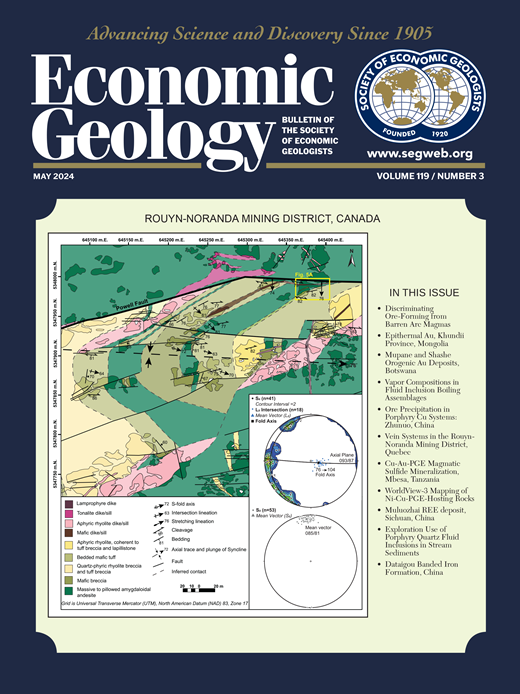Contrasting Features and Volcanostratigraphy of the Mafic-Hosted Mandoos and Shinas Volcanogenic Massive Sulfide Deposits, Samail Ophiolite, Oman
IF 4.9
1区 地球科学
Q1 GEOCHEMISTRY & GEOPHYSICS
引用次数: 0
Abstract
Despite the substantial amount of research on the Cretaceous Samail ophiolite in Oman, the factors controlling the size and metal endowment of the mafic-hosted, Cu-Au(-Zn-Ag) volcanogenic massive sulfide (VMS) deposits remain elusive. This work shows that the volcanostratigraphic position, hydrothermal venting style, and oxidation processes are critical factors controlling the distinct features of the Shinas and Mandoos deposits. Mandoos is a large (8 Mt, 1.8 wt % Cu, 0.18 g/ton Au) orebody preserving abundant primary vent-related features formed via mound growth and collapse within a wide hydrothermal field, overlying a poorly developed stockwork. The smaller Shinas deposit (0.8 Mt, 2.6 wt % Cu, 0.63 g/t Au) represents a higher-temperature system evolving from low fS2/fO2 conditions, locally sealed by jaspers, to a mound growth stage with widespread subseafloor brecciation/replacement with associated zone refining. Mandoos formed at the onset of the postaxial stage (Geotimes-Tholeiitic Alley transition), and Shinas is hosted within the Alley units. Volcanism in Samail was seemingly continuous, and the low ɛNd and Nb/Ta of the Shinas hanging-wall lavas record the onset of significant modifications of the mantle source during the postaxial stage. Mandoos is enriched in Te + As + Se ± Zn ± Ga ± Sb relative to Shinas, where higher Cu + Au + Tl ± Mo grades possibly reflect leaching of protoarc-like lavas. Rare earth element patterns in the ores mimicking the deposit footwall can be employed to constrain volcanostratigraphic positioning and indicate that the footwall lavas may also represent a source of metals. Formation of metal-rich ochres at the sea floor likely led to Cu + Au upgrading in the ores during seawater-induced oxidation, which was enhanced during subaerial gossan formation.阿曼Samail蛇绿岩Mandoos和Shinas岩浆型块状硫化物矿床特征对比及火山地层学研究
尽管对阿曼白垩纪Samail蛇绿岩进行了大量研究,但控制镁铁质、Cu-Au(-Zn-Ag)火山岩块状硫化物(VMS)矿床大小和金属赋存的因素仍然难以捉摸。研究表明,火山地层位置、热液喷流方式和氧化作用是控制Shinas和Mandoos矿床特征的关键因素。Mandoos是一个大型矿体(8 Mt, 1.8 wt % Cu, 0.18 g/t Au),保留了丰富的原生喷口相关特征,这些特征是在一个广泛的热液域中通过土丘生长和崩塌形成的,覆盖在一个不发达的网络上。较小的Shinas矿床(0.8 Mt, 2.6 wt % Cu, 0.63 g/t Au)代表了一个较高的温度系统,从低fS2/fO2条件(局部被碧玉密封)演变到一个土丘生长阶段,广泛的海底角化/替换伴随着相关区域的精制。Mandoos形成于后轴期(地统-拉斑岩巷过渡)的开始阶段,而Shinas则位于岩巷单元内。Samail的火山活动似乎是连续的,Shinas上壁熔岩的低Nd和Nb/Ta记录了地幔源在轴后阶段的显著变化。Mandoos相对于Shinas富集Te + As + Se±Zn±Ga±Sb,其中Cu + Au + Tl±Mo含量较高可能反映了原弧样熔岩的浸出。模拟矿床下盘的矿石中的稀土元素模式可以用来约束火山地层定位,并表明下盘熔岩也可能代表金属的来源。海底富金属赭石的形成可能在海水氧化过程中导致矿石中Cu + Au的升级,并在海底砾石形成过程中得到强化。
本文章由计算机程序翻译,如有差异,请以英文原文为准。
求助全文
约1分钟内获得全文
求助全文
来源期刊

Economic Geology
地学-地球化学与地球物理
CiteScore
10.00
自引率
6.90%
发文量
120
审稿时长
6 months
期刊介绍:
The journal, now published semi-quarterly, was first published in 1905 by the Economic Geology Publishing Company (PUBCO), a not-for-profit company established for the purpose of publishing a periodical devoted to economic geology. On the founding of SEG in 1920, a cooperative arrangement between PUBCO and SEG made the journal the official organ of the Society, and PUBCO agreed to carry the Society''s name on the front cover under the heading "Bulletin of the Society of Economic Geologists". PUBCO and SEG continued to operate as cooperating but separate entities until 2001, when the Board of Directors of PUBCO and the Council of SEG, by unanimous consent, approved a formal agreement of merger. The former activities of the PUBCO Board of Directors are now carried out by a Publications Board, a new self-governing unit within SEG.
 求助内容:
求助内容: 应助结果提醒方式:
应助结果提醒方式:


